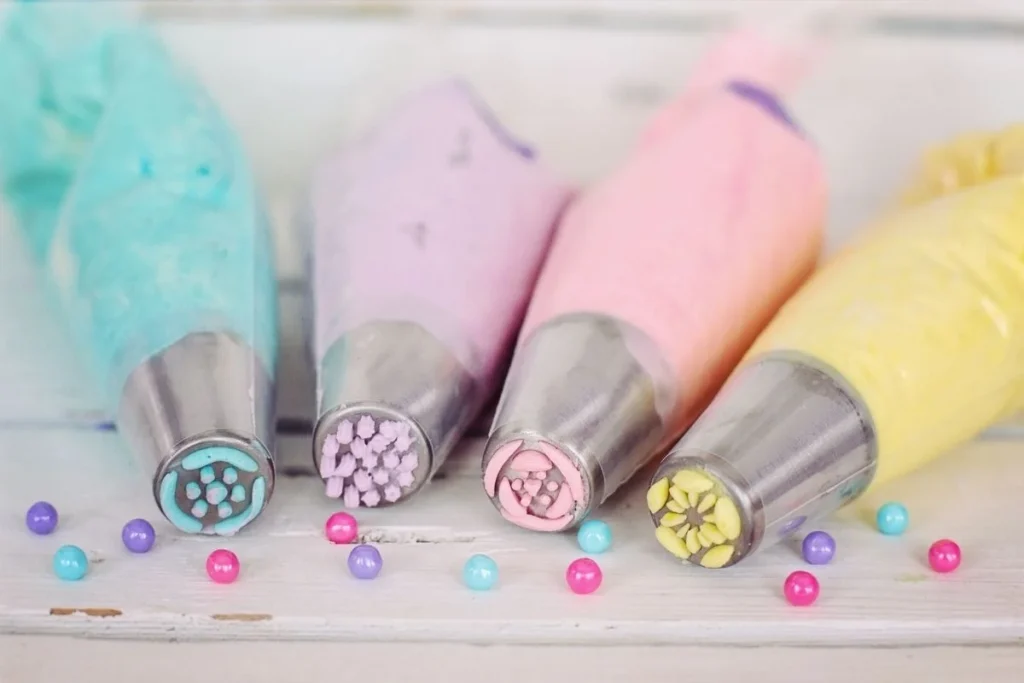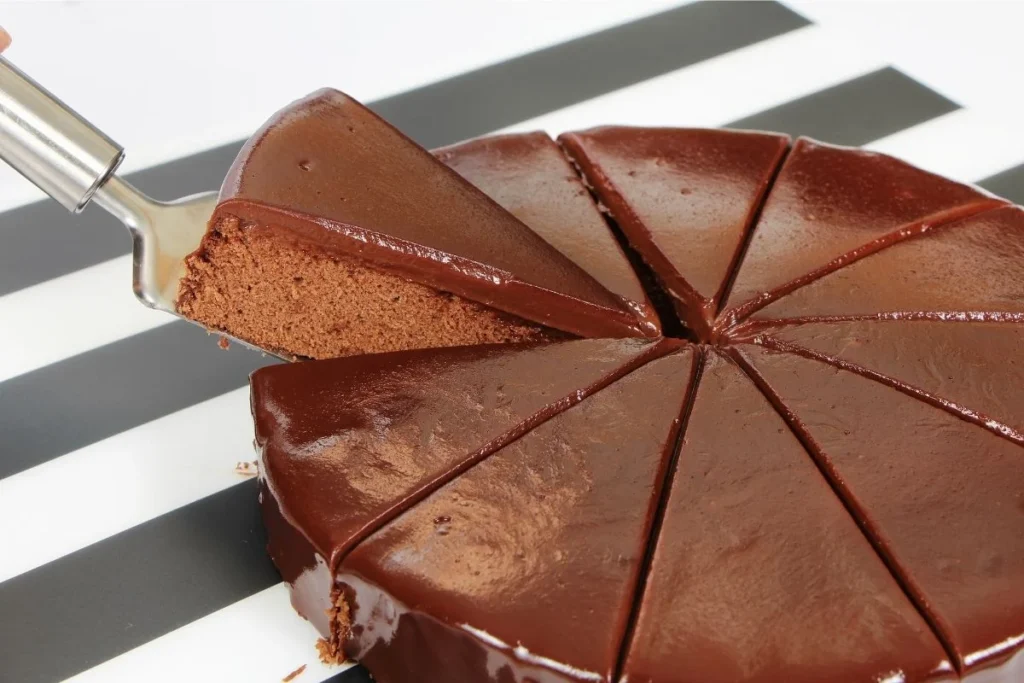
Baking a cake is a delightful experience, but what happens when you eagerly take that first bite only to discover that your cake is bitter? Don’t worry; all is not lost. There are simple and effective ways to salvage a bitter cake and turn it into a sweet masterpiece.
In this blog post, we’ll check out five simple methods to make your cake sweet again after it comes out of the oven. we also share common causes of bitter cake, and provide some tips on fixing a bitter chocolate cake after baking.
Table of Contents
ToggleWhy Does My Cake Taste Bitter After Baking | 4 Common Causes
A cake can sometimes taste bitter due to various reasons, and knowing these common issues can help you troubleshoot and improve your baking skills.
1. Overbaking
One major cause of a bitter flavor is overbaking. Baking times can differ, and going beyond the recommended duration can cause sugars in the recipe to caramelize, giving the cake a bitter undertone that overpowers its sweetness.
To avoid this, follow the suggested baking times in your recipe carefully. Use a toothpick or cake tester to make sure the cake is cooked through without becoming too bitter.
2. Ingredient Quality Matters
The choice and quality of ingredients also matter a lot. If you use expired or rancid ingredients, especially staples like flour, baking powder, or cocoa powder, you might introduce unwanted bitterness.
Always check the freshness of your ingredients before you start baking. Also, consider the type of cocoa powder you use, as some varieties can have a stronger bitter taste. Opt for high-quality, fresh ingredients to ensure a delicious outcome.
3. Measurements Matter
Incorrect measurements of ingredients can also contribute to bitterness. Baking is a precise science, and even small deviations from the recipe can lead to undesired results.
Too much of certain ingredients, like baking powder/soda or salt, can make the cake more bitter. Make sure to measure accurately by using the right tools, leveling off dry ingredients, and following the recipe closely.
4. Reactive Pans
Sometimes, the bitterness could come from using baking pans with a reactive surface. Reactive metals like aluminum can interact with certain ingredients, especially acidic ones, giving the cake a metallic taste.
To avoid this, choose non-reactive baking pans or line reactive pans with parchment paper. This simple adjustment can make a big difference in the overall taste of your cake.

How to Fix Bitter Cake After Baking in 5 Easy Methods
So, you baked a cake, and it turned out kinda bitter. No worries – we’ve got your back! Here are five simple tricks to turn that not-so-great cake into a delicious dessert.
1. Sweetening Things Up with More Sugar
One of the simplest ways to counteract bitterness in a cake is to add more sugar. Sugar can balance out the bitter notes and enhance the overall sweetness of your creation.
Begin by preparing a simple sugar syrup. In a saucepan, combine equal parts sugar and water, then heat the mixture until the sugar dissolves. Allow it to cool before brushing the syrup over the cake’s surface.
Be sure to concentrate on areas where the bitterness is most pronounced. This method not only sweetens the cake but also adds moisture, making it more enjoyable.
2. Layer on the Frosting
A thick layer of sweet frosting can work wonders in masking the bitterness of a cake. Choose a frosting that complements the flavor of your cake, whether it’s a classic buttercream, cream cheese, or a rich chocolate ganache.
Spread a generous amount of frosting over the entire cake, making sure to reach the edges and corners. The sweetness and texture of the frosting will not only cover the bitter taste but also provide a luscious contrast to the cake’s crumb.
3. Citrus Zest and Juices
Citrus fruits, such as lemons and oranges, can be powerful allies in neutralizing bitterness. The natural acidity and bright flavors of citrus can help balance out the unwanted taste in your cake. Grate the zest of a citrus fruit and sprinkle it over the cake for a burst of freshness.
Additionally, consider brushing the cake with citrus juice, which not only imparts flavor but also moistens the cake. This method adds a delightful citrusy twist that can transform the cake into a refreshing treat.
4. Masking with Flavored Syrups
Introducing flavored syrups is another effective strategy to combat bitterness. Create a syrup infused with vanilla, almond, or any other extract that complements the cake’s flavor profile.
Apply the syrup evenly across the surface of the cake, allowing it to seep into the layers. This method not only sweetens the cake but also imparts a subtle, pleasant flavor that can help distract from any lingering bitterness.
Experiment with different extracts to find the perfect match for your specific cake.
5. Moisture Boost with Milk or Simple Syrup
Sometimes, a bitter taste can be a result of dryness in the cake. Combat this by injecting moisture back into the layers. Use a pastry brush to apply a thin layer of milk or a simple syrup made from equal parts sugar and water.
The liquid will be absorbed by the cake, revitalizing its texture and helping to alleviate any bitterness. Be cautious not to oversaturate the cake; a light touch is often sufficient to achieve the desired effect.

Common Mistakes to Avoid When Fixing a Bitter Cake
While it’s great that you want to save your creation, there are some common mistakes that many bakers make. Let’s look at these pitfalls and figure out how to avoid them for a successful cake makeover.
- Going Overboard with Sweetness: When your cake tastes bitter, the first reaction might be to add more sugar, thinking it will balance things out. However, it’s important not to go overboard. Too much sugar can make your cake overly sweet, fixing one problem but potentially creating another. Find the right balance to ensure sweetness without overpowering the other flavors.
- Not Paying Attention to Texture: While taste is crucial, ignoring your cake’s texture during the fixing process can be a big mistake. Some bakers add moisture-enhancing ingredients without thinking about the overall texture, resulting in a soggy or dense outcome. Strike a balance to make sure your cake is moist while keeping a desirable texture.
- Forgetting About Flavor Harmony: Fixing a bitter cake often means adding new flavors to mask the bitterness. However, it’s a mistake to ignore how well these added flavors work with the original taste. Introducing incompatible flavors can create a confusing and unappetizing mix. Choose complementary flavors that enhance the overall taste instead of creating a mishmash of conflicting sensations.
- Depending Too Much on Toppings: Toppings can help distract from the bitter taste, but relying solely on them is a mistake. Some bakers go all out with extravagant toppings, hoping to divert attention. While toppings can improve the look, they should complement the cake’s taste, not just cover it up. Strike a balance between aesthetics and flavor for a truly enjoyable experience.
- Skipping the Quality Check: In the rush to fix a bitter cake, some bakers might forget a crucial step – checking the quality before making corrections. Not tasting and evaluating the cake in its current state can lead to misguided adjustments. Take the time to assess the bitterness and identify any secondary issues before making fixes. This ensures a more informed and effective approach to saving your cake.
- Ignoring Personal Preferences: Everyone’s taste is unique, and what works for one person may not work for another. Ignoring personal preferences when fixing a bitter cake can result in a solution that doesn’t suit your taste buds. Consider your flavor preferences and those of your intended audience. Customize the fixing process to align with the tastes you enjoy, ensuring a satisfying result.
- Overlooking Baking Time and Temperature Adjustments: Fixing a bitter cake isn’t just about adding ingredients; it also involves revisiting the baking process. Some bakers may forget the impact of adjusting baking time and temperature. Ignoring these factors can affect the overall taste, texture, and moisture content of the cake. Experiment with slight adjustments to find the optimal balance for your specific recipe.
Creative Frosting and Filling Options to Mask Bitterness
There are some cool and tasty ways to cover up the bitterness with creative frosting and filling options, making your baking mishap a pleasant surprise for your taste buds.

Sweet and Tangy Citrus Frosting
Use citrus flavors like lemon or orange to counteract bitterness. Make a sweet and tangy citrus frosting by mixing powdered sugar, butter, and a hint of citrus zest. The zesty notes not only balance out the bitter taste but also give your cake a refreshing twist.
Spread the citrus frosting generously on your cake, making sure each bite is a burst of vibrant flavors that distract from any lingering bitterness.
Creamy Nutella Filling
If your cake is a bit too chocolatey and bitter, a creamy Nutella filling can make a big difference. The hazelnut undertones in Nutella go well with chocolate. Just slice your cake horizontally and spread a thick layer of Nutella between the layers.
Not only does this filling add a rich texture to your cake, but it also introduces a delightful mix of sweet and nutty flavors that can effectively cover up any bitterness.
Fruity Jam Layers
Add a layer of fruity jam between the cake layers to bring in a burst of sweetness and fruity goodness. Raspberry, strawberry, or apricot jams work well to shift the focus from the bitter notes. The natural sugars in the jam will create a pleasant contrast and enhance the overall taste of your cake.
Spread the jam evenly between the layers, creating a colorful and flavorful surprise in every slice.
Mocha Coffee Infusion
For coffee-flavored cakes that lean towards bitterness, try infusing a mocha coffee flavor into your frosting. Mix cocoa powder into your favorite coffee-flavored frosting recipe and generously cover your cake. The combo of chocolate and coffee will not only boost the richness of your cake but also hide any unwelcome bitterness.
This option works especially well for those who like a hint of bitterness but want it balanced with other flavors.
Caramel Drizzle Extravaganza
The rich and buttery sweetness of caramel can transform the taste of your cake. Make a smooth caramel drizzle by mixing sugar, butter, and cream. Drizzle the caramel generously over the cake, letting it seep into the layers.
The sweet and gooey texture of caramel will not only add decadence to your cake but also do a great job of hiding any bitterness.

Expert Tips to Fix a Bitter Chocolate Cake After Baking
Fixing a too-bitter chocolate cake after baking takes some careful steps and a few expert tricks to turn your cooking blunder into a tasty treat.
Bitterness in a chocolate cake can come from different things, like the chocolate type, overmixing, or overbaking. Here are some expert tips to rescue your bitter chocolate cake and make it a sweet success.
- First off, figure out where the bitterness is coming from. If you use unsweetened or dark chocolate with a lot of cocoa, that might be the culprit. Counteract it by adding sweetness. Make a simple syrup by dissolving sugar in hot water, then gently brush it over the cake. This not only adds sweetness but also helps keep the cake moist.
- You can also adjust the sweetness by layering the cake. Cut it into layers and put a sweet filling between them, like chocolate ganache or flavored frosting. This not only hides the bitterness but also adds layers of flavor and texture.
- Think about adding other flavors to balance out the bitterness. A fruit compote or sweetened whipped cream can bring in a taste that works well with the chocolate. Berries, citrus, or a hint of coffee can help harmonize the flavors.
- Moisture is key to fighting bitterness. If your cake is dry, it makes the bitterness worse. Fix this by drizzling the cake with flavored syrup, fruit juice, or even a bit of liqueur to add moisture and boost the overall taste.
- Get creative with different frostings and toppings. A rich, sweet frosting can balance out the bitterness. Cream cheese frosting, in particular, can create a tasty contrast. Also, think about adding toppings like nuts, shredded coconut, or sprinkles to distract from the bitter taste.
- If the bitterness is mild, try serving the cake with a scoop of vanilla ice cream. The cold, creamy texture and sweetness of the ice cream can effectively cover up any lingering bitterness in each bite.
- Lastly, the best way to deal with bitterness is to prevent it. Pay attention to the chocolate you use, and pick one with a balanced cocoa content. Be careful with the baking time, as overbaking can make the bitterness worse. Follow the recipe closely and use high-quality ingredients for a deliciously sweet chocolate cake.
Final Thoughts
Even experienced bakers can run into problems while baking, and the good news is, that there are easy ways to fix a cake that turns out bitter. Whether you go for a sugary syrup soak, fruity puree, creamy frosting, rich chocolate ganache, or zesty citrus, each option provides a special way to save your dessert and transform it into a delicious treat.
So, if you ever find yourself dealing with a bitter cake, don’t worry – give one of these simple solutions a try and enjoy the sweet taste of success with every bite. Happy baking!
Lindsey Mackenzie
About me
Hi there! I’m Lindsey Mackenzie, the founder of Bake Smartly. Baking has been my passion since childhood, growing up in my father’s bakery. With Bake Smartly, I’m excited to share my love for all things sweet and savory. Join me on this delicious journey as we whip up scrumptious treats and sprinkle joy into every bite!






